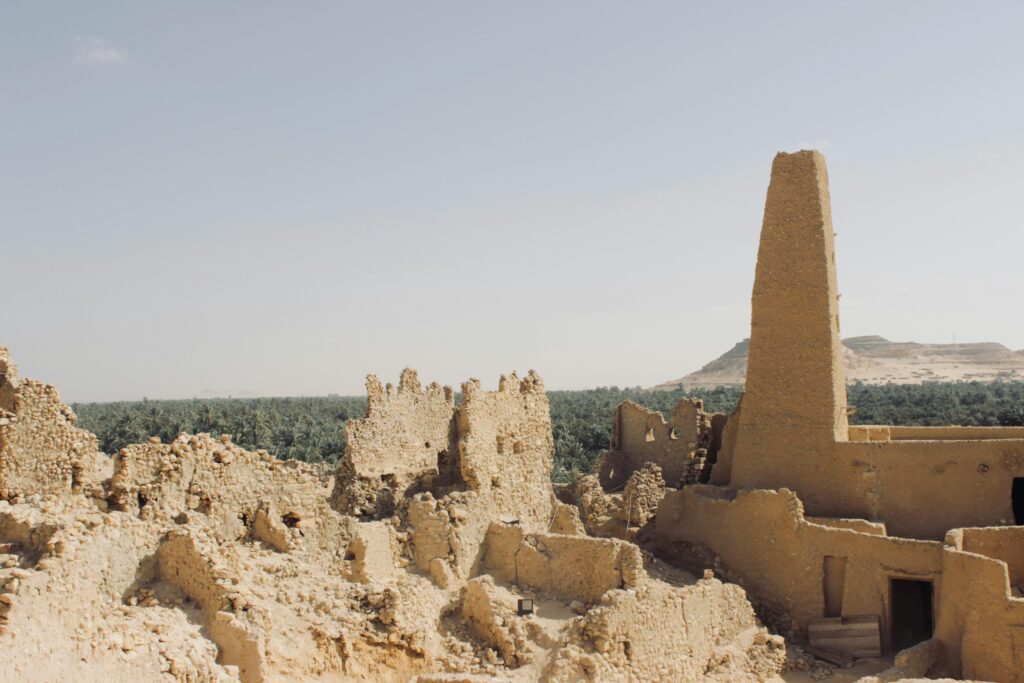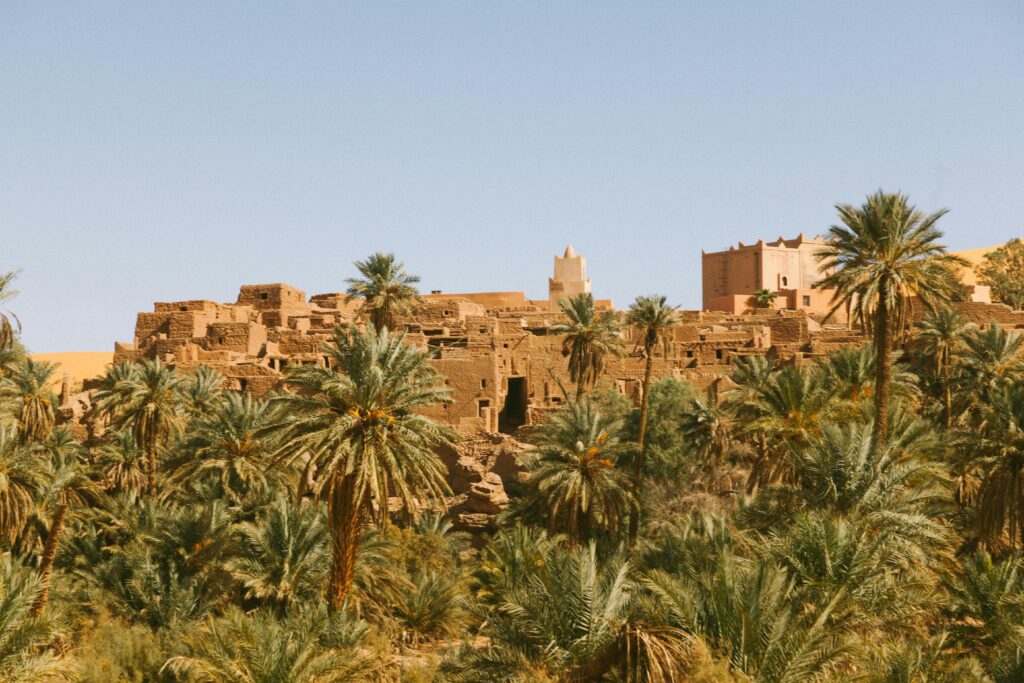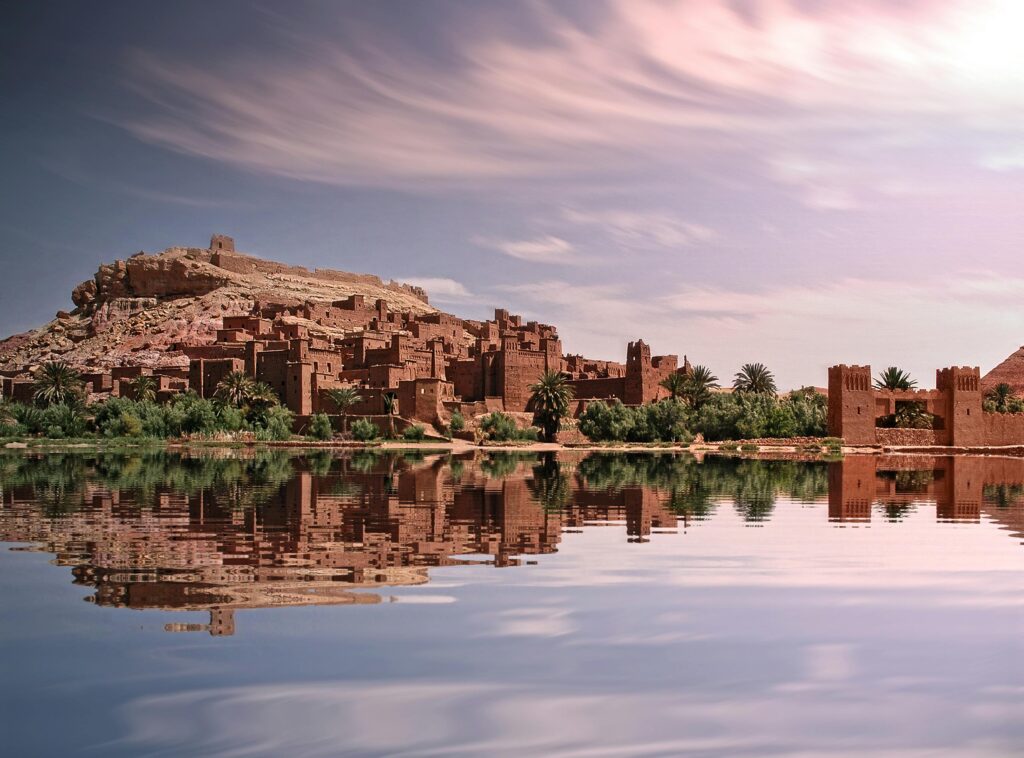Introduction: Discovering Egypt’s Hidden Desert Paradise
As the sun dips below the horizon, painting the sky in fiery hues of orange and pink, I stand atop a towering sand dune, the vast Sahara stretching endlessly before me. The warm desert breeze carries the faint scent of salt from nearby lakes, mingling with the earthy aroma of date palms. Below, the mud-brick ruins of Shali Fortress glow golden in the fading light, a silent testament to centuries of history. This isn’t the Egypt of crowded pyramids and bustling bazaars—this is Siwa Oasis, a secluded sanctuary where time moves at its own pace.
Nestled deep in Egypt’s Western Desert, near the Libyan border, Siwa is a world apart. Here, the indigenous Berber (Amazigh) culture thrives, ancient ruins whisper forgotten histories, and salt lakes shimmer under the relentless desert sun. The oasis is a labyrinth of olive groves, freshwater springs, and winding alleyways lined with traditional mud-brick homes.

Siwa Oasis is more than just a travel destination—it’s an immersion into a way of life untouched by modernity. Whether you’re a history buff tracing Alexander the Great’s footsteps, an adventure seeker racing down dunes, or simply a soul craving serenity, this guide will help you uncover the best of Siwa.
Why Visit Siwa Oasis?
✔ Unique Berber Culture – One of Egypt’s last Amazigh strongholds, with its own language and traditions.
✔ Ancient Ruins – The legendary Oracle of Amun, visited by Alexander the Great, once stood here.
✔ Natural Wonders – Crystal-clear springs, blinding white salt lakes, and endless dunes of the Great Sand Sea.
✔ Off-the-Beaten-Path – Far from Egypt’s tourist crowds, offering an authentic, unhurried experience.
Pro Tip: Siwa isn’t just a stop—it’s a journey into another world. Plan at least 3-4 days to fully experience its magic.
Map of Siwa Oasis
Best Time to Visit Siwa Oasis
Siwa’s desert climate is extreme, with scorching summers (June-August, up to 45°C/113°F) and chilly winters (December-February, dropping to 5°C/41°F at night). The best times to visit are during the shoulder seasons, when temperatures are mild and the landscape is at its most inviting.
Ideal Seasons:
✅ October-November & March-April – Daytime temperatures hover around 25-30°C (77-86°F), perfect for exploring ruins and swimming in springs. Nights are cool but comfortable.
✅ Winter (December-February) – Days are pleasant (15-20°C/59-68°F), but nights can be surprisingly cold. Pack layers!
Avoid: Mid-summer (June-August) unless you love extreme heat. Many attractions close in the afternoon due to the scorching sun.
Festival Highlight:
– Siwa Festival (October): A vibrant celebration of Amazigh culture, featuring traditional music, dance, and local crafts. If you can time your visit, don’t miss it!
How to Get to Siwa Oasis
Siwa is remote—no airports or trains—but getting there is part of the adventure. The journey itself offers stunning desert vistas and a sense of isolation that prepares you for the oasis’s tranquility.
From Cairo (Best Option)
🚗 By Bus (10-12 hours) – West Delta Bus Co. runs daily overnight buses from Cairo’s Turgoman Station. Tickets cost ~$15-20. The buses are basic but air-conditioned.
🚗 Private Car (8-9 hours) – Hiring a driver (~$150-200) offers flexibility. The route passes through Marsa Matruh, where you can stop for a Mediterranean seafood lunch.
From Alexandria (Closer but Less Frequent)
🚌 Bus (6-7 hours) – Buses run sporadically; check schedules in advance. The route is scenic, crossing vast salt flats and desert plateaus.
Pro Tip: Roads are long and desolate—pack snacks, water, and patience! Fuel stations are rare, so fill up before leaving major cities.

Top Attractions in Siwa Oasis
1. The Temple of the Oracle (Ruins of Aghurmi)
📍 Why Visit? This ancient temple was once home to the Oracle of Amun, which Alexander the Great consulted in 331 BC to confirm his divine lineage. The ruins, though weathered, still exude an aura of mystery.
📸 Best Photo Spot: Climb to the highest point at sunset for panoramic views over the oasis.
💡 Insider Tip: Hire a local guide to explain the temple’s history—many are descendants of Siwa’s original Berber inhabitants.
2. Cleopatra’s Spring (Ain el-Hammam)
💧 Legend Says: Cleopatra bathed in these crystal-clear waters. Today, it’s a popular swimming spot, with a natural pool surrounded by palm trees.
⚠ Note: Dress modestly—locals still use this spring for daily chores. Women should wear a t-shirt over swimwear.
🌿 Sensory Detail: The water is cool and silky, with a faint mineral tang. Dragonflies dart across the surface, and the shade of the palms offers respite from the sun.
3. Fatnas Island (Fantasy Island)
🌅 Sunset Must-Do: Cross a narrow causeway to this palm-fringed island, where a rustic café serves sweet mint tea. The view of the sun setting over Lake Siwa is unforgettable.
🍽 Try: Siwan dates with fresh goat cheese, a local delicacy.
4. Great Sand Sea (Dune Adventures)
🏜 Must-Try: A 4×4 desert safari to the towering dunes, followed by sandboarding at sunset. The silence of the desert is profound—no cars, no people, just the wind sculpting the sands.
🌌 Nighttime Magic: Some tours include a Berber-style campfire dinner under a blanket of stars.
5. Siwa Salt Lakes
📸 Instagram Alert: The blinding white salt crusts create surreal, otherworldly landscapes. Walk carefully—the salt is sharp!
🧂 Local Industry: Siwa’s salt is harvested traditionally and sold in markets—a great souvenir.
Hidden Gem: Gebel al-Mawta (Mountain of the Dead) – A hill riddled with ancient tombs, some adorned with faded frescoes of Egyptian gods. The quiet here is haunting.
Where to Stay in Siwa Oasis
Budget (Under $30/night)
🏨 Shali Lodge – A charming mud-brick guesthouse with rooftop views of the fortress. Rooms are simple but clean, with shared bathrooms. The owner, Mahmoud, serves homemade breakfasts of fresh bread and Siwan honey.
🏨 Palm Trees Hotel – Basic but centrally located, with a lush garden perfect for evening tea.
Mid-Range ($30-$80/night)
🏩 Adrère Amellal Ecolodge – A luxurious yet sustainable retreat with no electricity—just candlelight and starlight. The hotel blends seamlessly into the desert cliffs.
🏩 Albabenshal Hotel – A historic fortress-turned-hotel, with rooms overlooking the old town. The rooftop restaurant serves delicious tagine.
Splurge ($100+)

💎 Siwa Paradise – Private villas with palm-shaded pools, ideal for honeymooners. The on-site spa offers salt scrubs using local minerals.
Pro Tip: Book ahead in peak seasons (Oct-Apr). Many lodges have limited rooms.
Local Cuisine: Must-Try Siwan Dishes
🍽 1. Tagilla – Siwa’s iconic bread, baked in hot sand and ashes. It’s dense, slightly smoky, and perfect for dipping in olive oil or honey.
🍽 2. Fatta – A festive dish of layered rice, crispy bread, and tender lamb, drizzled with garlicky tomato sauce.
🍽 3. Dates & Olive Oil – Siwa’s organic dates are legendary—try them with locally pressed olive oil for a simple, divine snack.
Personal Anecdote: I joined a local family for dinner in their palm-thatched home. We sat on woven mats, eating tagilla dipped in golden honey while the grandmother shared stories of Siwa’s past. The warmth of their hospitality was as memorable as the food.
Restaurant Recommendations:
– Abdu’s Restaurant: Try the stuffed pigeon, a Siwan specialty.
– Alexander’s Café: Fresh juices and rooftop views of the oasis.
3-Day Siwa Oasis Itinerary
Day 1: History & Culture
☀ Morning: Temple of the Oracle + Shali Fortress ruins (climb for panoramic views).
🌤 Afternoon: Cleopatra’s Spring swim + Explore the bustling local market (buy handmade silver jewelry).
🌙 Evening: Sunset at Fatnas Island with mint tea.
Day 2: Desert Adventures
☀ Morning: 4×4 safari to the Great Sand Sea (stop at hidden oases).
🌤 Afternoon: Salt lakes & sandboarding (bring sunglasses—the glare is intense!).
🌙 Evening: Berber dinner under the stars (listen to traditional music).
Day 3: Relaxation & Hidden Gems
☀ Morning: Gebel al-Mawta tombs + Siwa House Museum (learn about Amazigh culture).
🌤 Afternoon: Swim in Bir Wahed’s hot spring (a desert paradise).
🌙 Evening: Stargazing with a local astronomer.
Travel Tips for Siwa Oasis
✔ Cash is King – Few ATMs; bring Egyptian pounds.
✔ Dress Modestly – Shoulders and knees covered, especially near springs.
✔ No Alcohol – Siwa is conservative; enjoy fresh hibiscus tea instead.
✔ Hire a Guide – Essential for desert trips (they know hidden oases).
Packing List:
– Lightweight scarf (for sun/sand protection).
– Sturdy sandals (the terrain is hot and rocky).
– Reusable water bottle (stay hydrated!).
Frequently Asked Questions (FAQ)
1. Is Siwa Oasis safe for solo travelers?
✅ Yes! Crime is rare, but avoid wandering the desert alone.
2. Can I visit Siwa as a day trip?
❌ No. It’s too remote—minimum 2 nights recommended.
3. Do I need a visa for Siwa?
✔ Yes, Egypt’s standard visa applies.
4. Is English widely spoken?
🔄 Basic English is understood in tourist areas; learn a few Arabic phrases.
5. What’s the best way to explore the desert?
🚙 Book a local guide—they know hidden oases and safe routes.
Conclusion: Your Siwa Adventure Awaits
Siwa Oasis isn’t just a place—it’s an experience. From the whispering palms to the endless dunes, every moment here feels like a step back in time. Whether you’re soaking in a natural spring or tracing Alexander the Great’s footsteps, Siwa leaves an indelible mark.
Ready to explore? Start planning your Siwa Oasis adventure today—before the world discovers this hidden gem!
📌 Save this guide for later!
Note: “Start planning your Siwa Oasis (Egypt) adventure today—before it’s no longer a secret!”
Keywords:
Siwa Oasis Egypt travel things to do in Siwa Oasis Egypt where to stay in Siwa Oasis Egypt when is the best time to visit Siwa Oasis Egypt Siwa Oasis Egypt attractions



